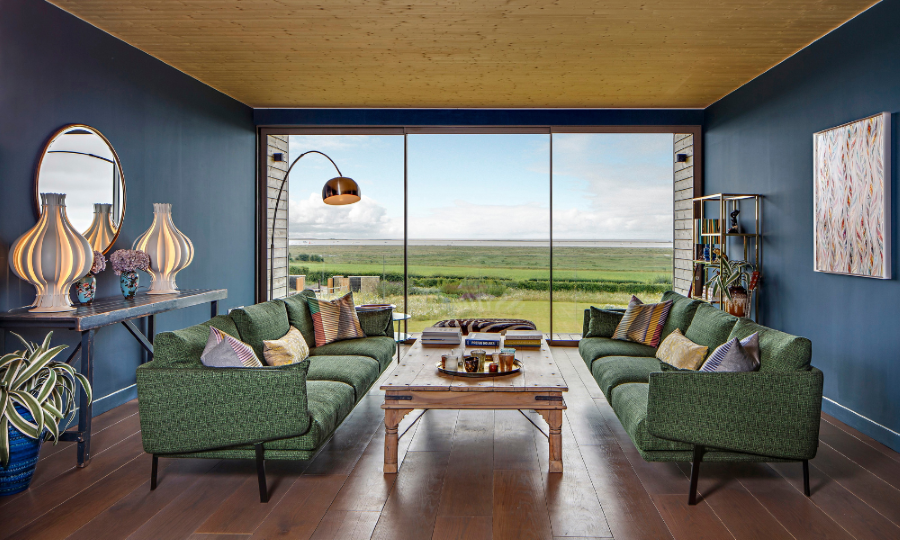With the summer weather already feeling like a distant memory and more time being spent indoors, that doesn’t mean that you can’t still enjoy your garden.
Home improvement specialists at IDSystems have rounded up some top tips from the experts to help make the view from your garden window or bi-fold door feel like a piece of artwork, explaining how these tactics helped transform client Bliss Blakeney’s coastal property:
“Bliss Blakeney on the North Norfolk coast enjoys stunning views over the salt marshes and out to sea”, explains Edward Stobart, IDSystems’ Technical Sales Manager. “When the owners designed and built the house they dedicated a whole room to the view, with the entire wall of the sea-facing elevation filled with narrow framed glazing. The glazing is recessed back from the edge of the wall, creating a balcony on the outside but also helping to focus the view through the glass and out to sea.”
Choosing a frame that accentuates the scene
Square-edged window profiles in a colour that contrasts to the internal decor are ideal (Image: IDSystems / Charles Hosea / Loyn & Co Architects)
When choosing a window frame that accentuates the garden view, Edward Stobart, Technical Sales Manager at IDSystems recommends opting for slim, minimalist frames that allow for large panes of uninterrupted glass, maximising the visibility of the outside. He explains: “Aluminium windows tend to be ideal because they are able to combine big panes of glass with minimal visible frames.
“Beyond that, square-edged window profiles in a colour that contrasts to the internal decor are ideal because they provide a clear border to the view out, focusing your eyes on the view through the window, not at the window itself.”
For a more artistic effect, modern trends such as asymmetrical window arrangements can add character to contemporary homes, while deep reveals around picture windows create cosy nooks that frame the view beautifully. Edward Stobart comments: “Window seats have become hugely popular and are ideal for making the view out seem more artistic. Being closer to the glass allows you to take more of the view in because you see less of the room itself.”
Using indoor elements to draw attention to the garden view
Furniture placements should frame the view (Image: IDSystems / David Butler Photography / Llewellyn Harker Lowe Architects)
Indoor design can improve your garden view and help connect the interior and exterior. As landscape designer Sari Lampinen notes, “Whether the garden view is contrasting or perfectly harmonious with the room’s interior, you’ve got to know your style and the guidelines that support it to make a wonderful and successful combination by unifying the exterior with the interior.”
Painting walls in light, neutral tones allows the garden to take centre stage, much like art in a gallery. Home stager Megan Morris emphasises this, stating: “The walls in art galleries are always white because it draws your focus to the art itself and allows the colours to be seen in their purest form.”
Furniture placement should be carefully considered to frame the view, while avoiding distractions like heavy curtains. Adding plants or natural textures indoors can further blur the lines between inside and outside, creating a seamless, inviting connection to the view.
Covering up unsightly parts of your garden
There are many ways to cover unsightly parts in your garden (Image: Blooming Artificial)
Not everyone has a blank slate to start from. Your garden view may even be ruined by an eyesore such as a crumbling wall or an old shed. In this case, covering up or distracting from the offending features may be your best bet.
Alick Burnett, Managing Director at Blooming Artificial, says: “Living walls are fantastic for hiding away crumbling walls and old fences. Combine them with flowers and you’ve got yourself a beautiful feature for your garden.
“Geraniums, fuchsias and wallflowers work beautifully to give a summery feel to your garden, the only downside is that they aren’t in bloom all year round. To counteract this, consider opting for a faux living wall including flowering options such as an artificial gardenia screen.”
Learn from the masters: Your window as a canvas
Furniture placements should frame the view (Image: IDSystems / David Butler Photography / Llewellyn Harker Lowe Architects)
The best way to turn your garden view into art is to consider the window your canvas, and apply some key composition techniques from the masters. Professional artist and author of “Fine Art Tips” Lori McNee recommends:
-
Avoiding symmetry and even distribution of elements across the view.
-
Placing the focal point in the centre can make the view feel static. Instead, position your focal points off-centre to add dynamism and engagement.
-
Incorporating natural or implied lines that lead the viewer’s eye through the composition. For example, a winding path or a line of bushes.
Top tips for choosing a window to maximise your view from Edward Stobart
Q: Do you have any glass specs considerations to enhance the view?
A: “For large picture windows when it comes to specifying the glass it is important to consider two things, firstly if your window is south facing then you may wish to opt for glass with a solar control coating – this reduces the amount of heat from direct sunlight that the window lets in. If your window isn’t south facing then a low-iron glass is worth considering because its extra transparency will provide a better view out.”
Q: How can you minimise glare or reflection that may interfere with the view?
A: “If your window is south facing then direct sunlight may interfere with your view. If you are building an extension or a new-build home then there may be the opportunity to install louvres or brize-soleil or design an overhang above your large picture window, this will reduce the reflections on the glass and better frame the view out.”




